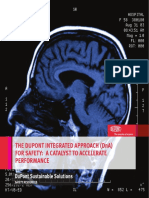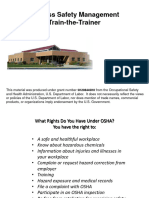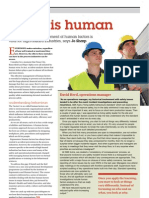Process Safety Leadership Engaging With Senior Managers
Process Safety Leadership Engaging With Senior Managers
Uploaded by
sl1828Copyright:
Available Formats
Process Safety Leadership Engaging With Senior Managers
Process Safety Leadership Engaging With Senior Managers
Uploaded by
sl1828Copyright
Available Formats
Share this document
Did you find this document useful?
Is this content inappropriate?
Copyright:
Available Formats
Process Safety Leadership Engaging With Senior Managers
Process Safety Leadership Engaging With Senior Managers
Uploaded by
sl1828Copyright:
Available Formats
Health and Safety Executive
Process Safety Leadership: Engaging with Senior Managers
Ian Travers
Head of Chemical Industries Strategy Unit Hazardous Installations Directorate
Corporate Responsibility
We live in an age of corporate social responsibility Successful businesses demonstrate that they take good care It is becoming a case of who cares wins Good words, corporate branding, commitments made in policy statements or glossy brochures is not enough it is delivery that counts
Successful process safety management is essential for business success
Failure in process safety management can never deliver sustainable business success The consequences of getting control of major hazard wrong is extremely costly Getting it right pays large dividends
Process Safety
Process safety is shorthand for the ways in which major hazard risks are controlled one companys accident is everyones problem root causes are often common across all organisations. only as good as the weakest in your sector
Process Safety Leadership:
Successful process safety management is essential for business success Leaders: need to understand major hazard risks within their companies Should ensure process safety management is managed in a systematic way identify vulnerability and be sceptical should focus on major hazard safety outcomes Should work together, across industry, to share lessons and good practice
So leadership is vital but what does it consist of?
The vision of the organisation. The way in which: Process safety is given the right degree of attention and focus; Process safety considerations feature in key business decisions, and Understanding of major hazard risk and the importance of critical control measures is communicated and championed. what we do when no one is looking or checking up on us.
Engagement with Senior Managers
Operators, managers, engineers, contractors and members of the Board all have a role Senior managers who make the big decisions and plant managers who make the day to day decisions have the most important role Engineers and safety professionals who have expertise need to engage with senior managers in improving understanding of process safety risks. Use of non-technical terms and presenting issues in a plane everyday way is important
Management systems were both deficient and not properly followed, control room staff had little control over flow rates and timing of receipt and did not have sufficient information to manage precisely the storage of incoming fuel
A culture where keeping the process operating was the primary focus and process safety did not get the attention, resources or priority that it required
Leaders Need To Understand and Assess the Risks
What hazards are present What are the challenges to plant integrity/containment How can this give rise to a major accident What is the likelihood and what are the consequences
Manage process safety in a systematic way
Based on a recognised PSM standard, eg CCPS guidelines Multiple layers of protection based on James Reasons Swiss cheese model Tailored to the risks not one size fits all Systems designed to manage conventional safety dont easily transfer to major hazard risks PSM must be dynamic and never fixed
People
Processes
Plant
Process Safety Control Measures (Barriers) Preventive Barriers Mitigation Barriers
MAJOR HAZARD
Loss of Containment
Outcome
Determine the Control Measures (Barriers)
Identify Vulnerability
Know exactly how the plant containment might fail Know what the critical control measures are Recognise that people are the weakest part of a PSMS
Risk Profile
Control measures tailored according to the riskprofile. More emphasis, more in-depth control in parts of the process where numerous challenges to integrity and consequences are significant
People are the weakest part of a PSM system
Senior Executives because: Dont understand risk Trust absolutely the system design Make business decisions without understanding the impact on process safety management Dont know how to challenge what they are being told Have a strong bias towards messages about success
Focus on Process Safety Outcomes
Leaders should: focus on process safety outcomes and not draw comfort from the complexity of the control measures and the systems Question perfection - never fully believe that risks are being adequately controlled should actually know based on information from Key Process Safety Indicators KPIs Identify failings and act quickly and decisively dont just measure and feel good
PSM Senior Executive Training
Addressing leadership shortcomings has not been easy, as whilst there are any number of training courses available for engineers there is very little on offer for senior leaders of major hazard organisations, despite the fact that understanding the risk from a major accident is just as important as understanding every other type of business risk, if not more so. The good news is that industry and the regulator have recently come together to develop recognised training standards in process safety leadership and process safety management for everyone from front line operators to the chief executive of a major hazard organisation.
OECD Guidelines on Process Safety Governance June 2015
A team of international experts in process safety and leadership have written guidelines focused on helping chief executives and senior leaders recognise their impact upon process safety. These guidelines are designed to be readily adopted within existing corporate governance programmes such as Responsible Care, or can be used as a standalone set of principles by major hazard organisations, where the stakes are high and consequences extreme.
How engineers can help: Top Ten Tips for Success
Present process safety risks as business risks rather than relying solely on complex technical arguments when speaking to senior leaders Keep process safety on the agenda at all meetings, and offer to present process safety updates to senior management meetings. Avoid jargon!
10 Top Tips
Help senior executives to understand the basics of process safety management and take business decisions in the light of the potential impact on safety Ensure that senior leaders understand that process safety risk management needs a systematic approach based on several layers of protection, and that a one size fits all is not adequate.
10 Top Tips
In simple terms describe the risk profile for your part of the business and highlight the most critical control measures Explain that despite having expertise and diligence in risk assessment and design of protective measure nothing is ever perfect and flaws will appear, systems deteriorate, often without any immediate adverse impact but this erosion of the protective measures often goes unnoticed or checked and indeed tolerated
10 Top Tips
Make the case for focused process safety performance information being provided to the management team Provide real and focused evidence and data that highlights where systems have deteriorated in a format that can be readily understood by senior managers and include the potential consequences, backed up by previous real-life incidents, where possible
10 Top Tips
Show senior leaders the TCE article Advise your most senior manager(s) of the availability of the Process Safety Leadership training course
Safety resources Loss prevention bulletin from IChemE
Improving process safety by sharing experience www.icheme.org/losspreventionbulletin
Safety and Loss Prevention Special Interest Group
Forthcoming event Accident consequence modelling in the process industries latest development, 21 February 2012 http://www.icheme.org/SafetyConsequenceModellingFlyer
Training courses
Train from the top down with Process safety and the board at executive level to graduate level with Fundamentals of process safety www.icheme.org/courses
Thank you .. Any questions?
You might also like
- Business Plan - C2 Water Refilling Station-1 (1) .3Document51 pagesBusiness Plan - C2 Water Refilling Station-1 (1) .3Roxette Marie84% (43)
- Guidelines for Defining Process Safety Competency RequirementsFrom EverandGuidelines for Defining Process Safety Competency RequirementsRating: 3 out of 5 stars3/5 (1)
- The Dupont Integrated Approach (Dna) For Safety: A Catalyst To Accelerate PerformanceDocument5 pagesThe Dupont Integrated Approach (Dna) For Safety: A Catalyst To Accelerate PerformanceAdiwirabrata Diponegoro100% (1)
- PSM Workbook CanadaDocument56 pagesPSM Workbook CanadaSPIDERMAB33100% (1)
- Process Safety ManagementDocument85 pagesProcess Safety ManagementFaiz Abdullah75% (4)
- Bow Ties in Risk ManagementDocument43 pagesBow Ties in Risk ManagementAndrés Vega100% (4)
- Process Safety Management GuideDocument39 pagesProcess Safety Management Guidesl1828100% (7)
- Guidelines for Auditing Process Safety Management SystemsFrom EverandGuidelines for Auditing Process Safety Management SystemsNo ratings yet
- 2B201-454EN - Aquilion Premium - TroubleshootingDocument33 pages2B201-454EN - Aquilion Premium - TroubleshootingSwami MeeraNo ratings yet
- Spring Issue of The Dirt 2010Document24 pagesSpring Issue of The Dirt 2010Vermont Nursery & Landscape AssociationNo ratings yet
- PSM Element 1Document38 pagesPSM Element 1Mircea Caprar100% (2)
- 07process Safety Performance Indicators Health and Safety ExecutiveDocument23 pages07process Safety Performance Indicators Health and Safety ExecutiveSergio A. Rdz. F.No ratings yet
- HAZID - IntroductionDocument9 pagesHAZID - IntroductionAmin ZoharNo ratings yet
- Jepg ... SJEC - Jan 2023 Module On PROCESS SAFETYDocument20 pagesJepg ... SJEC - Jan 2023 Module On PROCESS SAFETYL JayanthiNo ratings yet
- LOPA DefinitionDocument49 pagesLOPA Definitionbtjajadi100% (1)
- Efficient PHA of Non-Continuous Operating ModesDocument25 pagesEfficient PHA of Non-Continuous Operating ModesShakirNo ratings yet
- Risk Based SafetyDocument6 pagesRisk Based Safetysalman ahmedNo ratings yet
- PSM Culture AssesmentDocument13 pagesPSM Culture AssesmentDave CNo ratings yet
- Bow TIE ModelDocument36 pagesBow TIE Modeldmpresas100% (1)
- Process Safety Europeasn ConferenceDocument193 pagesProcess Safety Europeasn ConferenceGustavo Agudelo100% (2)
- Managers Guide To PSM - January 2006Document10 pagesManagers Guide To PSM - January 2006rw992049No ratings yet
- Intro To PSM at UI-WCP Oct 2019 (Workshop)Document60 pagesIntro To PSM at UI-WCP Oct 2019 (Workshop)Aditya Setiadi100% (1)
- Process Safety AccidentsDocument44 pagesProcess Safety Accidentskanakarao1100% (5)
- Process Safety CapabilitiesDocument17 pagesProcess Safety CapabilitiesJitendra Kumar100% (1)
- Epsc PSFDocument23 pagesEpsc PSFKNS GroupNo ratings yet
- Trevor Kletz-Learning From Accidents-Gulf Professional (2001)Document156 pagesTrevor Kletz-Learning From Accidents-Gulf Professional (2001)Raju100% (2)
- CCPS - Building Process Safety Culture - Tools To Enhance PS Performance - Challenger Case HistoryDocument6 pagesCCPS - Building Process Safety Culture - Tools To Enhance PS Performance - Challenger Case Historysl1828100% (1)
- Introduction To Inherently Safer DesignDocument15 pagesIntroduction To Inherently Safer DesignJP_Bourke100% (1)
- Process Safety Event PSE Reporting Gui-334210Document45 pagesProcess Safety Event PSE Reporting Gui-334210Abdullah AlbusaidiNo ratings yet
- OSHA - PSM Train The TrainerDocument44 pagesOSHA - PSM Train The TrainerShiva RamaswamyNo ratings yet
- FE Moment - Process SafetyDocument5 pagesFE Moment - Process SafetyVitaliy Yashchenko100% (1)
- A Practical Approach To Managing Safety Critical Equipment and Systems in Process PlantsDocument10 pagesA Practical Approach To Managing Safety Critical Equipment and Systems in Process Plantsfredo405No ratings yet
- Fundamental of Process Safety Management System (PSM)Document41 pagesFundamental of Process Safety Management System (PSM)Basaci AbdelghaffarNo ratings yet
- Measuring Culture by Lynn Watts PDFDocument27 pagesMeasuring Culture by Lynn Watts PDFManoj Varrier100% (1)
- PSM Course 2014 Day 1Document55 pagesPSM Course 2014 Day 1dcd1980100% (1)
- Six Steps To Effectively Update and Revalidate PHAsDocument8 pagesSix Steps To Effectively Update and Revalidate PHAspolaris44No ratings yet
- Process Safety Fundamentals: An IntroductionDocument32 pagesProcess Safety Fundamentals: An IntroductionCesar PumaNo ratings yet
- PSM Safety Critical Equipment 1713620016Document67 pagesPSM Safety Critical Equipment 1713620016Wahid Akram100% (2)
- Risktec Drilling Soc 0.3Document16 pagesRisktec Drilling Soc 0.3mashanghNo ratings yet
- Chapter 3 Concept of Hazard AvoidanceDocument53 pagesChapter 3 Concept of Hazard AvoidanceAnas HussainNo ratings yet
- DOE Handbook: Process Safety Management ForDocument180 pagesDOE Handbook: Process Safety Management ForFerri FatraNo ratings yet
- YPMT OPS PR 0027 - 旁路管理程序 OverrideBypass Management ProcedureDocument21 pagesYPMT OPS PR 0027 - 旁路管理程序 OverrideBypass Management ProcedureShanying PengNo ratings yet
- L4 PHA Student HandoutDocument165 pagesL4 PHA Student Handoutjosethompson100% (2)
- CCPS ProcessSafety Metrics 2011 FINALDocument44 pagesCCPS ProcessSafety Metrics 2011 FINALTriod jackson100% (7)
- HEMP Training PDFDocument3 pagesHEMP Training PDFMuhammad.SaimNo ratings yet
- 3chemical and Process Safety Management 23111Document137 pages3chemical and Process Safety Management 23111DaNo ratings yet
- Process Safety Management TrainingDocument232 pagesProcess Safety Management TrainingTallal Joiya92% (25)
- Implementation of A Risk-Based Process Safety Management SystemDocument22 pagesImplementation of A Risk-Based Process Safety Management SystemDeepak Dubey100% (2)
- Safety Moments ProcessDocument13 pagesSafety Moments Processvisutsi100% (1)
- Inherently Safer DesignDocument64 pagesInherently Safer Designchetan_7927No ratings yet
- One Day Seminar: A Report ForDocument5 pagesOne Day Seminar: A Report ForBrijesh100% (2)
- Piper Alpha Disaster SlidesDocument26 pagesPiper Alpha Disaster SlidesAzmi MohamedNo ratings yet
- Process Safety - Sources of IgnitionDocument48 pagesProcess Safety - Sources of IgnitionAhmed HamadNo ratings yet
- Effective Implementation of Process Safety Management PDFDocument107 pagesEffective Implementation of Process Safety Management PDFmirsupiusman100% (2)
- Fire and Explosion Hazard Management Rev 1Document36 pagesFire and Explosion Hazard Management Rev 1fxgb0% (1)
- Hazards & Effects Management Process: Course ContentsDocument2 pagesHazards & Effects Management Process: Course ContentsMuhammad.SaimNo ratings yet
- Process Safety AlarpDocument20 pagesProcess Safety Alarpvisutsi100% (1)
- 1-Safety & Layers of Protection PDFDocument105 pages1-Safety & Layers of Protection PDFInter TungNo ratings yet
- CCPS Monograph Reflections From Global Process Safety LeadersDocument29 pagesCCPS Monograph Reflections From Global Process Safety LeadersKiranNo ratings yet
- Consequence Modeling and PSMDocument35 pagesConsequence Modeling and PSMTom Tao100% (1)
- Learning's From Major Process Safety Incidents Learning's From Major Process Safety IncidentsDocument32 pagesLearning's From Major Process Safety Incidents Learning's From Major Process Safety IncidentsDave CNo ratings yet
- Confirmation Bias - What You Can DoDocument9 pagesConfirmation Bias - What You Can Dosl1828No ratings yet
- Sterile Cockpit - Train Staff To Stay Focused in Safety Critical Tasks, No Matter What Their JobDocument6 pagesSterile Cockpit - Train Staff To Stay Focused in Safety Critical Tasks, No Matter What Their Jobsl1828No ratings yet
- Toolbox Talk - Lightning StrikesDocument1 pageToolbox Talk - Lightning Strikessl1828No ratings yet
- IChemE - TCE - To Err Is HumanDocument2 pagesIChemE - TCE - To Err Is Humansl1828No ratings yet
- IChemE - TCE - Top Five Facts Everyone Should Know About Oil ExplorationDocument4 pagesIChemE - TCE - Top Five Facts Everyone Should Know About Oil Explorationsl1828No ratings yet
- Toolbox Talk - Means of EgressDocument1 pageToolbox Talk - Means of Egresssl1828No ratings yet
- Toolbox Talk - Mounting and Dismounting EquipmentDocument1 pageToolbox Talk - Mounting and Dismounting Equipmentsl1828No ratings yet
- IChemE - XX-2008-Paper-11 - Bunding at Buncefield - Successes, Failures & Lessons LearnedDocument13 pagesIChemE - XX-2008-Paper-11 - Bunding at Buncefield - Successes, Failures & Lessons Learnedsl1828No ratings yet
- Toolbox Talk - Safety Around High VoltageDocument1 pageToolbox Talk - Safety Around High Voltagesl1828No ratings yet
- Food & Drink: Case Study: UnileverDocument3 pagesFood & Drink: Case Study: Unileversl1828No ratings yet
- Battery Care and Tips2Document1 pageBattery Care and Tips2SCCstudent99No ratings yet
- Toolbox Talk - Fume Hood RepairDocument3 pagesToolbox Talk - Fume Hood Repairsl1828No ratings yet
- CSB - Summary of Explosive & Toxic Incident Recommendations (1998-2013)Document32 pagesCSB - Summary of Explosive & Toxic Incident Recommendations (1998-2013)sl1828No ratings yet
- Toolbox Talk - Water PumpsDocument1 pageToolbox Talk - Water Pumpssl1828No ratings yet
- Report of Inspection, Testing & Maintenance of Fire Pump AssembliesDocument6 pagesReport of Inspection, Testing & Maintenance of Fire Pump Assembliessl1828100% (1)
- Toolbox Talk - Fume Hood DecommissionDocument3 pagesToolbox Talk - Fume Hood Decommissionsl1828No ratings yet
- CEFIC - ICE-Distribution Emergency Response Guidelines For Use by The Chemical Industry (2011)Document15 pagesCEFIC - ICE-Distribution Emergency Response Guidelines For Use by The Chemical Industry (2011)sl1828No ratings yet
- CSB Digest Union Carbide Nitrogen Asphyxiation (1998)Document2 pagesCSB Digest Union Carbide Nitrogen Asphyxiation (1998)sl1828No ratings yet
- Chemical Engineering - Hazardous Area ClassificationDocument1 pageChemical Engineering - Hazardous Area Classificationsl1828No ratings yet
- CEFIC - Measuring & Managing Co2 Emissions of European Chemical TransportDocument40 pagesCEFIC - Measuring & Managing Co2 Emissions of European Chemical Transportsl1828No ratings yet
- CSB Digest West Pharmaceutical Dust Explosion (2003)Document2 pagesCSB Digest West Pharmaceutical Dust Explosion (2003)sl1828No ratings yet
- CSB - Digest - Herrig Brothers - Propane Tank Explosion (1998)Document2 pagesCSB - Digest - Herrig Brothers - Propane Tank Explosion (1998)sl1828No ratings yet
- CEFIC Guidelines Transport Equipment Packed Cargo (2010)Document7 pagesCEFIC Guidelines Transport Equipment Packed Cargo (2010)sl1828No ratings yet
- Define Health Measure and Explain How It Differs From Life ExpectancyDocument2 pagesDefine Health Measure and Explain How It Differs From Life ExpectancyDebbie Tan Zi JingNo ratings yet
- ILD - DR - Dianiati - Satsim9Document44 pagesILD - DR - Dianiati - Satsim9Hendi GamingNo ratings yet
- Pressure Meter ApageoDocument2 pagesPressure Meter ApageoDoni Garcia100% (1)
- Epos Pocket Guide 2012Document20 pagesEpos Pocket Guide 2012Margaretha Syane LientunganNo ratings yet
- IeC 61439 - LegrandDocument64 pagesIeC 61439 - LegrandTapas HiraNo ratings yet
- Scoggins Middle School Tennis 411 Paine JenniferDocument2 pagesScoggins Middle School Tennis 411 Paine Jenniferapi-251669765No ratings yet
- No More Rejection!Document16 pagesNo More Rejection!johnakioNo ratings yet
- Battery Life Enhancer - UtkarshDocument11 pagesBattery Life Enhancer - UtkarshNaveen AggarwalNo ratings yet
- Mindfulness Meditation Therapy (MMT) and Pistol ShootingDocument33 pagesMindfulness Meditation Therapy (MMT) and Pistol ShootingJohn OsborneNo ratings yet
- Lean 4Document9 pagesLean 4Arun PrasadNo ratings yet
- The Curious Case of Benjamin Button Movie Analysis - Kamonwan 1003Document5 pagesThe Curious Case of Benjamin Button Movie Analysis - Kamonwan 1003api-283804229No ratings yet
- Final FNCPDocument4 pagesFinal FNCPoctoberttwentythreeNo ratings yet
- AML Detection Scenarios Transaction Monitoring Sample TemplateDocument10 pagesAML Detection Scenarios Transaction Monitoring Sample Templatepooja kumariNo ratings yet
- 1) Introduction 2) Features 3) Diagrams/description 4) Operation 5) Flow Chart 6) ConclusionDocument5 pages1) Introduction 2) Features 3) Diagrams/description 4) Operation 5) Flow Chart 6) ConclusionSanjay YadavNo ratings yet
- Trigeminal Nerve FinalDocument101 pagesTrigeminal Nerve FinalShraddha PatilNo ratings yet
- Schrack Power PCB Relay RP II/1Document3 pagesSchrack Power PCB Relay RP II/1IBJSC.comNo ratings yet
- Ote PB2022Document46 pagesOte PB2022Kelley FritzNo ratings yet
- Asag 03 0351Document10 pagesAsag 03 0351Nabin GhimireNo ratings yet
- G8 1st PERIODICAL TEST MAPEH8Document7 pagesG8 1st PERIODICAL TEST MAPEH8Ian Santos B. SalinasNo ratings yet
- June 24Document64 pagesJune 24Amit NathNo ratings yet
- Tenses: II. Choose The Underlined Part in Each Sentence (A, B, C, or D) That Needs CorrectingDocument2 pagesTenses: II. Choose The Underlined Part in Each Sentence (A, B, C, or D) That Needs CorrectingYếnKimNo ratings yet
- HSE Perfomance Report Jan-21Document2 pagesHSE Perfomance Report Jan-21Bassam HSENo ratings yet
- Drilling and Blasting ProblemsDocument30 pagesDrilling and Blasting ProblemsAhmad Abu AlasalNo ratings yet
- 2006 08 Static ElectricityDocument1 page2006 08 Static ElectricityRizki DarmawanNo ratings yet
- Israel, Gennelyn - Case Study 3 - Topic 3Document56 pagesIsrael, Gennelyn - Case Study 3 - Topic 3Gennelyn IsraelNo ratings yet
- Is 15298.2.2011 PDFDocument32 pagesIs 15298.2.2011 PDFDipankar ChakrabortyNo ratings yet
- Allianz Prime Cover BrochureDocument17 pagesAllianz Prime Cover Brochurevf5jmszwg2No ratings yet
















































































































